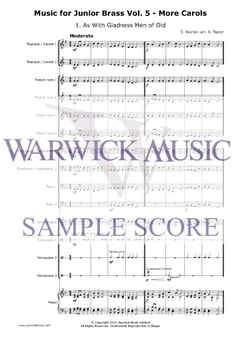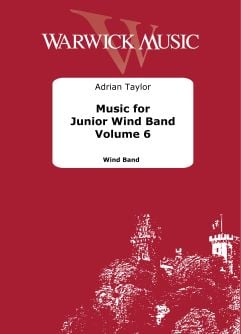'Music For Junior Brass And Wind' Is Perfect For School Band Libraries
August 23rd, 2022
4 min read
By Ewan Moore
.jpg?width=1510&height=630&name=template%20(11).jpg)
With the back to school period fast approaching, you’ll no doubt be considering which new arrangements are right for your school band library. They’ll need to be accessible, of course, but also fun to play and great-sounding to keep the children motivated.
 Adrian Taylor’s latest volumes in Music for Junior Wind Band and Music for Junior Brass tick these all-important boxes. Warwick Music recently spoke with him about his newest arrangements to understand his process, the importance of accessibility, tips for learning to read music, and why his latest work really stands apart from the pack.
Adrian Taylor’s latest volumes in Music for Junior Wind Band and Music for Junior Brass tick these all-important boxes. Warwick Music recently spoke with him about his newest arrangements to understand his process, the importance of accessibility, tips for learning to read music, and why his latest work really stands apart from the pack.
Before we dive in, the newest volumes are:
-
Taylor: Music for Junior Wind Band Vol. 5 More Carols - Wind Band
-
Taylor: Music for Junior Brass Vol. 5 More Carols - Brass Ensemble
It's also worth noting that these latest volumes complete the collections that started with Music for Junior Brass Vol. 1 and Music for Junior Woodwind Vol. 1. Consider checking out the entire collections for a much more comprehensive range of pieces.
One of the most important things for Adrian when it comes to producing these volumes is really understanding the skills and limitations of those that will be performing the songs. The key, after all, is to help these budding musicians to sound as great as possible and help them learn in the process. 
“The first thing I consider when composing or arranging music is who I'm writing for and what limitations this imposes on the music,” Adrian tells us. “For example, when I write for the wind orchestra I conduct, I know the minimum entry level that the children need to be at in order to get into the group. So I write appropriately for that standard of player. When I’m writing for my school band, the arrangements need to be much more straightforward to suit their levels.”
Adrian explains that his arrangements for junior ensembles have become more creative over the years, evolving from quite simple arrangements of well-known melodies that were often homophonic in nature.
“They were more what I would call ‘orchestrations’ than musical ‘arrangements’”, he says. In Volumes 5, 6 & 7 of Music for Junior Brass and Music for Junior Wind there are a number of pieces where Adrian has been more creative, writing more imaginative arrangements or compositions than he had done previously.
Adrian uses ‘Variation on Hot Cross Buns’ (Music For Junior Brass/Wind Band Volume 7) as an example of how his style and approach have changed over time: “Where a simple harmonised melody also appears in a minor key and then in a jazzy style. I have learned that for young players, keeping much of the music homophonic and repetitive means you can play quite complex rhythm patterns in the arrangements, especially if words can be added to the rhythm to make it more memorable.”
It’s also hugely important to Adrian (and we're sure to any educators reading this right now) that his arrangements and compositions can be played by as many people as possible. For this, they need to be enjoyable to play and listen to!
 “My arrangements in the Music for Junior Brass and Music for Junior Wind Band series have two differentiated parts for every instrument (mostly). You don’t need a full band to perform them as the arrangements can be effectively played just by covering only four or five key parts. The ensemble can be supported by a piano if desired to fill out the chords, and each additional part added enhances the sound of the group. Most importantly, the arrangements sound good. That’s important to keep children motivated.”
“My arrangements in the Music for Junior Brass and Music for Junior Wind Band series have two differentiated parts for every instrument (mostly). You don’t need a full band to perform them as the arrangements can be effectively played just by covering only four or five key parts. The ensemble can be supported by a piano if desired to fill out the chords, and each additional part added enhances the sound of the group. Most importantly, the arrangements sound good. That’s important to keep children motivated.”
He adds: My biggest thrill is to hear that my music is being played by people from all over the world, not just by my own students or players in the bands I direct,” he tells us. “Having trombone study books on the ABRSM syllabus has certainly helped achieve this, and I'm always delighted to discover performances of my music on YouTube. Writing music that people want to play also has a financial benefit, as more people purchase the music.”
Adrian has been composing and arranging his own music since the tender age of 12, starting with the recorder before moving on to the trumpet, and eventually the trombone. He stuck with it because of the sheer joy of playing in bands, and for the incredible feeling that making music in a group can bring.
“My dream as a child was to be a trombonist for a professional orchestra and I was fortunate enough to get the opportunity to do so,” he recalls. “Even now, all these years later, I still get a great deal of enjoyment and job satisfaction from playing alongside other musicians in orchestras or bands. Without this performance element that remains a significant part of my career, I’m not sure that I would be as enthusiastic a teacher, conductor or composer/arranger as I am today. Even when I retire, I hope to still be playing for many years in bands and orchestras.”
“There are so many benefits to learning a musical instrument and playing in a band that it’s difficult to pick just one!” Adrian adds when we ask why children should always make an effort to play in groups when possible.
“I see so clearly when teaching instruments to young children how their levels of concentration and focus develop as they work out which notes to play whilst keeping the music in time. In addition to being great fun, joining a band also develops important life skills in children, such as a sense of responsibility, working together as a team, and listening to others. What is particularly great about the development of all these skills through playing instruments and joining a band, is that the child is having lots of fun at the same time!”
These days, Adrian gets to help other children set out on their own musical journey. What would be the single greatest piece of advice he could share with any budding composers out there? 
“Really know the instrument you’re composing for,” he answers. “As a trombonist, I’ve had music put in front of me that was physically impossible to play on the trombone unless you had three hands (one for the slide, another to operate the thumb valve and a third to work the Harmon mute inserted in the bell!). As a trombone player, I was able to write well for this instrument and I would always play through all the parts in my quartet arrangements to make sure they were playable by others.
“The first musical arrangements I had published (by Warwick Music) were therefore for trombone quartet. So, write first for the instruments you play before expanding to related instruments (e.g. others that share the same basic technique). When writing for instruments you don’t know much about, first find out from players of those instruments how they work, what their range is, and study good examples of compositions for that instrument.”
Browse a full range of educational resources and compositions at Warwick Music. You can also enjoy Adrian's work and wonderful talents over on YouTube!
After seven years writing about video games, Ewan made the jump to the music instrument industry to stop his family asking when he was going to get a real job. Mostly, though, he adores music and is passionate about its vital role throughout life - especially in education. He also played guitar in several bands with deeply embarrassing names that won't be revealed here. With a degree in journalism from an NCTJ-accredited university under his belt, Ewan uses everything he learned as a writer over the last decade to help answer any questions you might have about pBone Music in an accessible (and hopefully entertaining) way. Because if you can write 1,000 words on SSDs and ray-tracing, you can explain why plastic instruments are accessible, sustainable, and fun.